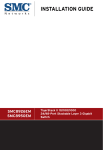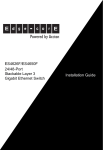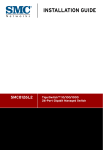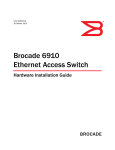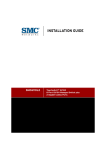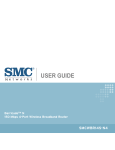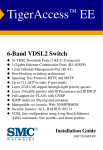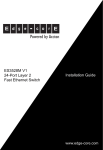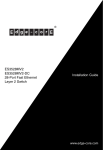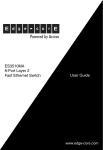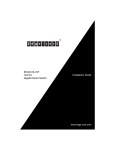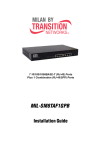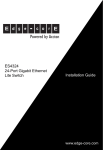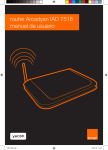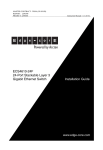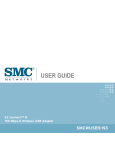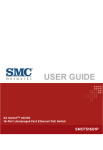Download SMC TigerSwitch
Transcript
INSTALLATION GUIDE ta SMC8126PL2-F TigerSwitchTM 10/100/1000 L2-Lite SMB PoE Gigabit Switch TigerSwitch 10/100/1000 Installation Guide From SMC's Tiger line of feature-rich workgroup LAN solutions 20 Mason Irvine, CA 92618 Phone: (949) 679-8000 September 2009 Pub. # 150200000032A E092009-MW-R01 Information furnished by SMC Networks, Inc. (SMC) is believed to be accurate and reliable. However, no responsibility is assumed by SMC for its use, nor for any infringements of patents or other rights of third parties which may result from its use. No license is granted by implication or otherwise under any patent or patent rights of SMC. SMC reserves the right to change specifications at any time without notice. Copyright © 2009 by SMC Networks, Inc. 20 Mason Irvine, CA 92618 All rights reserved. Printed in China Trademarks: SMC is a registered trademark; and EZ Switch, TigerStack and TigerSwitch are trademarks of SMC Networks, Inc. Other product and company names are trademarks or registered trademarks of their respective holders. Warranty and Product Registration To register SMC products and to review the detailed warranty statement, please refer to the Support Section of the SMC Website at http://www.smc.com. Compliances and Safety Warnings FCC - Class A This equipment has been tested and found to comply with the limits for a Class A digital device, pursuant to part 15 of the FCC Rules. These limits are designed to provide reasonable protection against harmful interference when the equipment is operated in a commercial environment. This equipment generates, uses, and can radiate radio frequency energy and, if not installed and used in accordance with the instruction manual, may cause harmful interference to radio communications. Operation of this equipment in a residential area is likely to cause harmful interference in which case the user will be required to correct the interference at his own expense. You are cautioned that changes or modifications not expressly approved by the party responsible for compliance could void your authority to operate the equipment. You may use unshielded twisted-pair (UTP) for RJ-45 connections - Category 3 or better for 10 Mbps connections, Category 5 or better for 100 Mbps connections, Category 5, 5e, or 6 for 1000 Mbps connections. For fiber optic connections, you may use 50/125 or 62.5/ 125 micron multimode fiber or 9/125 micron single-mode fiber. Industry Canada - Class A This digital apparatus does not exceed the Class A limits for radio noise emissions from digital apparatus as set out in the interference-causing equipment standard entitled “Digital Apparatus,” ICES-003 of the Department of Communications. Cet appareil numérique respecte les limites de bruits radioélectriques applicables aux appareils numériques de Classe A prescrites dans la norme sur le matériel brouilleur: “Appareils Numériques,” NMB-003 édictée par le ministère des Communications. i CE Mark Declaration of Conformance for EMI and Safety (EEC) This information technology equipment complies with the requirements of the Council Directive 89/336/EEC on the Approximation of the laws of the Member States relating to Electromagnetic Compatibility and 73/23/EEC for electrical equipment used within certain voltage limits and the Amendment Directive 93/68/EEC. For the evaluation of the compliance with these Directives, the following standards were applied: RFI Emission: • Limit class A according to EN 55022:1998 • Limit class A for harmonic current emission according to EN 61000-3-2/1995 • Limitation of voltage fluctuation and flicker in low-voltage supply system according to EN 61000-3-3/1995 Immunity: • Product family standard according to EN 55024:1998 • Electrostatic Discharge according to EN 61000-4-2:1995 (Contact Discharge: ±4 kV, Air Discharge: ±8 kV) • Radio-frequency electromagnetic field according to EN 61000-4-3:1996 (80 - 1000 MHz with 1 kHz AM 80% Modulation: 3 V/m) • Electrical fast transient/burst according to EN 61000-4-4:1995 (AC/DC power supply: ±1 kV, Data/Signal lines: ±0.5 kV) • Surge immunity test according to EN 61000-4-5:1995 (AC/DC Line to Line: ±1 kV, AC/DC Line to Earth: ±2 kV) • Immunity to conducted disturbances, Induced by radio-frequency fields: EN 61000-4-6:1996 (0.15 - 80 MHz with 1 kHz AM 80% Modulation: 3 V/m) • Power frequency magnetic field immunity test according to EN 61000-4-8:1993 (1 A/m at frequency 50 Hz) • Voltage dips, short interruptions and voltage variations immunity test according to EN 61000-4-11:1994 (>95% Reduction @10 ms, 30% Reduction @500 ms, >95% Reduction @5000 ms) LVD: • EN 60950-1:2001 Caution: Do not plug a phone jack connector in the RJ-45 port. This may damage this device. Attention: Les raccordeurs ne sont pas utilisés pour le système téléphonique! ii Safety Compliance Warning: Fiber Optic Port Safety CLASS I LASER DEVICE When using a fiber optic port, never look at the transmit laser while it is powered on. Also, never look directly at the fiber TX port and fiber cable ends when they are powered on. Avertissment: Ports pour fibres optiques - sécurité sur le plan optique DISPOSITIF LASER DE CLASSE I Ne regardez jamais le laser tant qu'il est sous tension. Ne regardez jamais directement le port TX (Transmission) à fibres optiques et les embouts de câbles à fibres optiques tant qu'ils sont sous tension. Warnhinweis: Faseroptikanschlüsse - Optische Sicherheit Niemals ein Übertragungslaser betrachten, während dieses LASERGERÄT DER KLASSE I eingeschaltet ist. Niemals direkt auf den Faser-TX-Anschluß und auf die Faserkabelenden schauen, während diese eingeschaltet sind. Advertencia: Seguridad del puerto de fibra óptica LASERGERÄT DER KLASSE I Cuando utilice un puerto de fibra óptica, nunca mire hacia el láser de transmisión mientras el mismo esté energizado. Asimismo, nunca mire directamente hacia el puerto de fibra óptica de transmisión ni a los extremos del cable de fibra óptica cuando estén energizados. PSE Alarm 本製品に同梱いたしております電源コードセットは、本製品専用です。本電源コード セットは、本製品以外の製品並びに他の用途でご使用いただくことは出来ません。 製品本体に同梱された電源コードセットを利用し、他製品の電源コードセットを使用し ないで下さい。 Power Cord Safety Please read the following safety information carefully before installing the switch: WARNING: Installation and removal of the unit must be carried out by qualified personnel only. • The unit must be connected to an earthed (grounded) outlet to comply with international safety standards. • Do not connect the unit to an A.C. outlet (power supply) without an earth (ground) connection. • The appliance coupler (the connector to the unit and not the wall plug) must have a configuration for mating with an EN 60320/IEC 320 appliance inlet. • The socket outlet must be near to the unit and easily accessible. You can only remove power from the unit by disconnecting the power cord from the outlet. • This unit operates under SELV (Safety Extra Low Voltage) conditions according to IEC 60950. The conditions are only maintained if the equipment to which it is connected also operates under SELV conditions. iii France and Peru only This unit cannot be powered from IT† supplies. If your supplies are of IT type, this unit must be powered by 230 V (2P+T) via an isolation transformer ratio 1:1, with the secondary connection point labelled Neutral, connected directly to earth (ground). Important! Before making connections, make sure you have the correct cord set. Check it (read the label on the cable) against the following: Power Cord Set U.S.A. and Canada The cord set must be UL-approved and CSA certified. The minimum specifications for the flexible cord are: - No. 18 AWG - not longer than 2 meters, or 16 AWG. - Type SV or SJ - 3-conductor The cord set must have a rated current capacity of at least 10 A The attachment plug must be an earth-grounding type with NEMA 5-15P (15 A, 125 V) or NEMA 6-15P (15 A, 250 V) configuration. Denmark The supply plug must comply with Section 107-2-D1, Standard DK2-1a or DK2-5a. Switzerland The supply plug must comply with SEV/ASE 1011. U.K. The supply plug must comply with BS1363 (3-pin 13 A) and be fitted with a 5 A fuse which complies with BS1362. The mains cord must be <HAR> or <BASEC> marked and be of type HO3VVF3GO.75 (minimum). Europe The supply plug must comply with CEE7/7 (“SCHUKO”). The mains cord must be <HAR> or <BASEC> marked and be of type HO3VVF3GO.75 (minimum). IEC-320 receptacle. Veuillez lire à fond l'information de la sécurité suivante avant d'installer le Switch: AVERTISSEMENT: L’installation et la dépose de ce groupe doivent être confiés à un personnel qualifié. • Ne branchez pas votre appareil sur une prise secteur (alimentation électrique) lorsqu'il n'y a pas de connexion de mise à la terre (mise à la masse). • Vous devez raccorder ce groupe à une sortie mise à la terre (mise à la masse) afin de respecter les normes internationales de sécurité. • Le coupleur d’appareil (le connecteur du groupe et non pas la prise murale) doit respecter une configuration qui permet un branchement sur une entrée d’appareil EN 60320/IEC 320. • La prise secteur doit se trouver à proximité de l’appareil et son accès doit être facile. Vous ne pouvez mettre l’appareil hors circuit qu’en débranchant son cordon électrique au niveau de cette prise. iv • L’appareil fonctionne à une tension extrêmement basse de sécurité qui est conforme à la norme IEC 60950. Ces conditions ne sont maintenues que si l’équipement auquel il est raccordé fonctionne dans les mêmes conditions. France et Pérou uniquement: Ce groupe ne peut pas être alimenté par un dispositif à impédance à la terre. Si vos alimentations sont du type impédance à la terre, ce groupe doit être alimenté par une tension de 230 V (2 P+T) par le biais d’un transformateur d’isolement à rapport 1:1, avec un point secondaire de connexion portant l’appellation Neutre et avec raccordement direct à la terre (masse). Cordon électrique - Il doit être agréé dans le pays d’utilisation Etats-Unis et Canada: Le cordon doit avoir reçu l’homologation des UL et un certificat de la CSA. Les spécifications minimales pour un cable flexible sont AWG No. 18, ouAWG No. 16 pour un cable de longueur inférieure à 2 mètres. - type SV ou SJ - 3 conducteurs Le cordon doit être en mesure d’acheminer un courant nominal d’au moins 10 A. La prise femelle de branchement doit être du type à mise à la terre (mise à la masse) et respecter la configuration NEMA 5-15P (15 A, 125 V) ou NEMA 6-15P (15 A, 250 V). Danemark: La prise mâle d’alimentation doit respecter la section 107-2 D1 de la norme DK2 1a ou DK2 5a. Suisse: La prise mâle d’alimentation doit respecter la norme SEV/ASE 1011. Europe La prise secteur doit être conforme aux normes CEE 7/7 (“SCHUKO”) LE cordon secteur doit porter la mention <HAR> ou <BASEC> et doit être de type HO3VVF3GO.75 (minimum). Seguridad del cable de alimentación eléctrica Antes de instalar el conmutador lea atentamente la siguiente información sobre seguridad: • Se debe conectar el equipo a un tomacorriente puesto a tierra (tierra física) para satisfacer las normas internacionales sobre seguridad. • No conecte el equipo a un tomacorriente (suministro eléctrico) de CA sin una conexión de tierra (tierra física). • El acoplador del dispositivo (el conector que va hacia el equipo y no el enchufe que va a la pared) deberá tener una configuración que coincida con la de la entrada de un dispositivo EN 60320/IEC 320. • El tomacorriente debe estar cerca del equipo y ser fácilmente accesible. Sólo se puede quitar la alimentación eléctrica al equipo desenchufando el cable de alimentación eléctrica del tomacorriente. v • Este equipo opera bajo las condiciones SELV (Safety Extra Low Voltage o Voltaje extra bajo de seguridad) de acuerdo con la norma IEC 60950. Las condiciones sólo se mantienen si la equipo al cual está conectado también opera bajo condiciones SELV. Francia y Perú únicamente Este equipo no puede ser energizado desde suministros IT†. Si su servicio eléctrico es del tipo IT, este equipo deberá ser alimentado con 230 V (2P+T) a través de un transformador de aislamiento de relación 1:1, con el punto de conexión del secundario rotulado Neutro conectado directamente a tierra (tierra física). ¡Importante! Antes de efectuar conexiones, asegúrese de que disponga del conjunto correcto de cables. Verifíquelo (lea la etiqueta del cable) contra lo siguiente: Conjunto de cables de alimentación eléctrica EE.UU. y Canadá El conjunto de cables deberá estar aprobado por UL y certificado por CSA. Las especificaciones mínimas del cable flexible son: - Nº 18 AWG, no mayor de 2 metros, o 16 AWG. - Tipo SV o SJ - tres conductores El conjunto de cables deberá tener una capacidad de corriente nominal de al menos 10 A. El enchufe de conexión deberá ser del tipo con puesta a tierra y tener una configuración NEMA 5-15P (15 A, 125 V) o NEMA 6-15P (15 A, 250 V). Dinamarca El enchufe de alimentación eléctrica deberá satisfacer la Sección 107-2-D1 de las normas DK2-1a o DK2-5a. Suiza El enchufe de alimentación eléctrica deberá satisfacer la norma SEV/ ASE 1011. Reino Unido El enchufe de alimentación eléctrica deberá satisfacer la norma BS1363 (tres clavijas 13 A) y estar provisto de un fusible de 5 A que satisfaga la norma BS1362. El cable de alimentación eléctrica debe estar marcado como <HAR> o <BASEC> y ser del tipo HO3VVF3GO.75 (mínimo). Europa El enchufe de alimentación eléctrica deberá satisfacer la norma CEE7/7 (“SCHUKO”). El cable de alimentación eléctrica debe estar marcado como <HAR> o <BASEC> y ser del tipo HO3VVF3GO.75 (mínimo). Receptáculo IEC-320. vi Bitte unbedingt vor dem Einbauen des Switches die folgenden Sicherheitsanweisungen durchlesen: WARNUNG: Die Installation und der Ausbau des Geräts darf nur durch Fachpersonal erfolgen. • Das Gerät sollte nicht an eine ungeerdete Wechselstromsteckdose angeschlossen werden. • Das Gerät muß an eine geerdete Steckdose angeschlossen werden, welche die internationalen Sicherheitsnormen erfüllt. • Der Gerätestecker (der Anschluß an das Gerät, nicht der Wandsteckdosenstecker) muß einen gemäß EN 60320/IEC 320 konfigurierten Geräteeingang haben. • Die Netzsteckdose muß in der Nähe des Geräts und leicht zugänglich sein. Die Stromversorgung des Geräts kann nur durch Herausziehen des Gerätenetzkabels aus der Netzsteckdose unterbrochen werden. • Der Betrieb dieses Geräts erfolgt unter den SELV-Bedingungen (Sicherheitskleinstspannung) gemäß IEC 60950. Diese Bedingungen sind nur gegeben, wenn auch die an das Gerät angeschlossenen Geräte unter SELV-Bedingungen betrieben werden. Stromkabel. Dies muss von dem Land, in dem es benutzt wird geprüft werden: Schweiz Dieser Stromstecker muß die SEV/ASE 1011Bestimmungen einhalten. Europe Das Netzkabel muß vom Typ HO3VVF3GO.75 (Mindestanforderung) sein und die Aufschrift <HAR> oder <BASEC> tragen. Der Netzstecker muß die Norm CEE 7/7 erfüllen (”SCHUKO”). Warnings and Cautionary Messages Warning: This product does not contain any serviceable user parts. Warning: Installation and removal of the unit must be carried out by qualified personnel only. Warning: When connecting this device to a power outlet, connect the field ground lead on the tri-pole power plug to a valid earth ground line to prevent electrical hazards. Warning: This switch uses lasers to transmit signals over fiber optic cable. The lasers are compliant with the requirements of a Class 1 Laser Product and are inherently eye safe in normal operation. However, you should never look directly at a transmit port when it is powered on. Caution: Wear an anti-static wrist strap or take other suitable measures to prevent electrostatic discharge when handling this equipment. Caution: Do not plug a phone jack connector in the RJ-45 port. This may damage this device. Les raccordeurs ne sont pas utilisé pour le système téléphonique! Caution: Use only twisted-pair cables with RJ-45 connectors that conform to FCC standards. vii Advertencias y mensajes de precaución Advertencia: Este producto no contiene ninguna pieza reparable por el usuario. Advertencia: La instalación y remoción del equipo sólo debe ser llevada a cabo por personal calificado. Advertencia: Cuando enchufe este aparato a un tomacorriente, conecte el cable de tierra del enchufe tripolar a una línea válida de tierra física para prevenir riesgos de tipo eléctrico. Advertencia: Este conmutador utiliza láseres para transmitir señales a través de un cable de fibra óptica. Los láseres satisfacen los requisitos de un producto láser Clase 1 y son intrínsecamente seguros para los ojos en operación normal. Sin embargo, nunca deberá mirar directamente a un puerto de transmisión cuando esté energizado.. Precaución Cuando manipule este equipo utilice una correa para la muñeca que proteja contra la electricidad estática o adopte otras medidas adecuadas tendientes a impedir las descargas electrostáticas. Precaución No inserte en el puerto RJ-45 un conector telefónico. Esto podría dañar el dispositivo. Les raccordeurs ne sont pas utilisé pour le système téléphonique! Precaución Sólo utilice cables de par retorcido con conectores RJ-45 que satisfagan las normas FCC. Environmental Statement The manufacturer of this product endeavours to sustain an environmentally-friendly policy throughout the entire production process. This is achieved though the following means: • Adherence to national legislation and regulations on environmental production standards. • Conservation of operational resources. • Waste reduction and safe disposal of all harmful un-recyclable by-products. • Recycling of all reusable waste content. • Design of products to maximize recyclables at the end of the product’s life span. • Continual monitoring of safety standards. End of Product Life Span This product is manufactured in such a way as to allow for the recovery and disposal of all included electrical components once the product has reached the end of its life. Manufacturing Materials There are no hazardous nor ozone-depleting materials in this product. Documentation All printed documentation for this product uses biodegradable paper that originates from sustained and managed forests. The inks used in the printing process are non-toxic. viii Purpose This guide details the hardware features of the switches, including their physical and performance-related characteristics, and how to install each switch. Audience This guide is for system administrators with a working knowledge of network management. You should be familiar with switching and networking concepts. Esta guía es para los administradores de sistemas que cuenten con conocimientos básicos de gestión de redes. Usted deberá estar familiarizado con los conceptos de conmutación y operación en red. Related Publications The following publication gives specific information on how to operate and use the management functions of the switches: The Management Guide Also, as part of both switches’ firmware, there is an online web-based help that describes all management related features. ix x Contents Chapter 1: Introduction Overview Switch Architecture Power-over-Ethernet Capability Network Management Options Description of Hardware 10/100/1000BASE-T Ports SFP Slots Port and System Status LEDs Mode PoE/Link Button Optional Redundant Power Unit Power Supply Socket Features and Benefits Connectivity Expandability Performance Management Chapter 2: Network Planning Introduction to Switching Application Examples Collapsed Backbone Network Aggregation Plan Remote Connections with Fiber Cable Making VLAN Connections Application Notes Chapter 3: Installing the Switch Selecting a Site Ethernet Cabling Equipment Checklist Package Contents Optional Rack-Mounting Equipment Mounting Rack Mounting Desktop or Shelf Mounting Installing an Optional SFP Transceiver Connecting to a Power Source 1-1 1-1 1-2 1-2 1-2 1-3 1-3 1-3 1-3 1-5 1-5 1-5 1-5 1-5 1-6 1-6 1-6 2-1 2-1 2-2 2-2 2-3 2-4 2-5 2-6 3-1 3-1 3-1 3-2 3-2 3-2 3-3 3-3 3-4 3-5 3-6 xi Contents Connecting to the Console Port Wiring Map for Serial Cable Chapter 4: Making Network Connections Connecting Network Devices Twisted-Pair Devices Cabling Guidelines Connecting to PCs, Servers, Hubs and Switches Network Wiring Connections Fiber Optic SFP Devices Connectivity Rules 1000BASE-T Cable Requirements 1000 Mbps Gigabit Ethernet Collision Domain 100 Mbps Fast Ethernet Collision Domain 10 Mbps Ethernet Collision Domain Cable Labeling and Connection Records 3-6 3-7 4-1 4-1 4-1 4-1 4-2 4-2 4-3 4-4 4-5 4-5 4-5 4-6 4-6 Appendix A: Troubleshooting A-1 Diagnosing Switch Indicators Power and Cooling Problems Installation In-Band Access A-1 A-1 A-1 A-2 Appendix B: Cables Twisted-Pair Cable and Pin Assignments 10BASE-T/100BASE-TX Pin Assignments Straight-Through Wiring Crossover Wiring 1000BASE-T Pin Assignments Cable Testing for Existing Category 5 Cable Adjusting Existing Category 5 Cabling to Run 1000BASE-T Fiber Standards B-1 B-1 B-1 B-2 B-2 B-3 B-4 B-4 B-4 Appendix C: Specifications C-1 Physical Characteristics Switch Features Management Features Standards Compliances C-1 C-2 C-2 C-3 C-3 xii Contents Appendix D: Ordering Information D-1 Appendix E: Spanish Instructions E-1 Selección de un sitio Montaje en bastidor E-1 E-1 Glossary Index xiii Tables Table 1-1 Table 1-2 Table 3-1 Table 4-1 Table 4-2 Table 4-3 Table 4-4 Table 4-5 Table 4-6 Table A-1 Table B-1 Table B-2 Table B-3 Table D-1 xiv Port Status LEDs System Status LEDs Serial Cable Wiring Maximum 1000BASE-T Gigabit Ethernet Cable Length Maximum 1000BASE-SX Gigabit Ethernet Cable Length Maximum 1000BASE-LX Gigabit Ethernet Cable Length Maximum 1000BASE-ZX Gigabit Ethernet Cable Length Maximum Fast Ethernet Cable Length Maximum Ethernet Cable Length Troubleshooting Chart 10/100BASE-TX MDI and MDI-X Port Pinouts 1000BASE-T MDI and MDI-X Port Pinouts Fiber Standards TIgerSwitch 10/100/1000 Products and Accessories 1-4 1-4 3-7 4-5 4-5 4-5 4-5 4-5 4-6 A-1 B-2 B-3 B-4 D-1 Figures Figure 1-1 Figure 1-2 Figure 1-3 Figure 1-4 Figure 1-5 Figure 1-6 Figure 2-1 Figure 2-2 Figure 2-3 Figure 2-4 Figure 3-1 Figure 3-2 Figure 3-3 Figure 3-4 Figure 3-5 Figure 3-6 Figure 3-7 Figure 4-1 Figure 4-2 Figure 4-3 Figure B-1 Figure B-2 Figure B-3 Figure E-1 Figure E-2 Front Panel Rear Panel Port LEDs System LEDs Mode Selection Power Supply Socket Collapsed Backbone Network Aggregation Plan Remote Connections with Fiber Cable Making VLAN Connections RJ-45 Connections Attaching the Brackets Installing the Switch in a Rack Attaching the Adhesive Feet Inserting an SFP Transceiver into a Slot Power Socket Serial Port (RJ-45) Pin-Out Making Twisted-Pair Connections Network Wiring Connections Making Connections to SFP Transceivers RJ-45 Connector Pin Numbers Straight-through Wiring Crossover Wiring Fijación de los soportes Instalación del conmutador en un bastidor 1-1 1-1 1-3 1-4 1-5 1-5 2-2 2-3 2-4 2-5 3-2 3-3 3-4 3-4 3-5 3-6 3-6 4-2 4-3 4-4 B-1 B-2 B-3 E-2 E-2 xv xvi Chapter 1: Introduction Overview The TigerSwitch 10/100/1000, SMC8126PL2-F, is an intelligent Layer 2 switch with 26 10/100/1000BASE-T ports, four of which are combination ports* that are shared with four SFP transceiver slots (see Figure 1-1, Ports 21-24). The switch’s 24 10/100/1000 Mbps ports support the IEEE 802.3af Power-over-Ethernet (PoE) standard that enables DC power to be supplied to attached devices over wire pairs in the connecting Ethernet cable. The SMC8126PL2-F includes an SNMP-based management agent embedded on the main board, which supports both in-band and out-of-band access for managing the switch. The switch can easily tame your network with full support for Spanning Tree Protocol, Multicast Switching, and Virtual LANs. It brings order to poorly performing networks by segregating them into separate broadcast domains with IEEE 802.1Q compliant VLANs, empowers multimedia applications with multicast switching and CoS services. RJ-45 Ports LED SMC8126PL2-F Mode button Port Status LEDs RJ-45 Ports (Non-PoE) Console Port 10/100/1000 Mbps RJ-45 Ports (PoE Ports) SFP Slots SFP Present System LEDs Figure 1-1 Front Panel AC Power Socket Redundant Power Supply Figure 1-2 Rear Panel * If an SFP transceiver is plugged in, the corresponding RJ-45 port is disabled for ports 21-24. 1-1 1 Introduction Switch Architecture The SMC8126PL2-F employs a wire-speed, non-blocking switching fabric. This permits simultaneous wire-speed transport of multiple packets at low latency on all ports. It also features full-duplex capability on all ports, which effectively doubles the bandwidth of each connection. This switch uses store-and-forward switching to ensure maximum data integrity. With store-and-forward switching, the entire packet must be received into a buffer and checked for validity before being forwarded. This prevents errors from being propagated throughout the network. Power-over-Ethernet Capability The switch’s 24 10/100/1000 Mbps ports support the Power-over-Ethernet (PoE) standard that enables DC power to be supplied to attached devices using wires in the connecting Ethernet cable. Any PoE compliant device attached to a port can directly draw power from the switch over the Ethernet cable without requiring its own separate power source. This capability gives network administrators centralized power control for devices such as IP phones and wireless access points, which translates into greater network availability. For each attached PoE device, the switch automatically senses the load and dynamically supplies the required power. The switch delivers power to a device using wire pairs in the UTP or STP cable. Ports 1~4 can provide up to 30W of power, and ports 5~24 can provide up to 15.4W. Network devices such as IP phones, wireless access points, and network cameras, typically consume less than 10 W of power, so they are ideal for Power-over-Ethernet applications. Network Management Options The SMC8126PL2-F contains a comprehensive array of LEDs for “at-a-glance” monitoring of network and port status. It also includes a management agent that allows you to configure or monitor the switch using its embedded management software, or via SNMP applications. To manage this switch, you can make a direct connection to the console port (out-of-band), or you can manage the switch through a network connection (in-band) using Telnet, the on-board web agent, or SNMP-based network management software. For a detailed description of this switch’s advanced features, refer to the Management Guide. 1-2 Description of Hardware 1 Description of Hardware 10/100/1000BASE-T Ports The SMC8126PL2-F contains 26 RJ-45 ports that operate at 10 Mbps or 100 Mbps, half or full duplex, or at 1000 Mbps, full duplex. Because all ports on this switch support automatic MDI/MDI-X operation, you can use straight-through cables for all network connections to PCs or servers, or to other switches or hubs. (See "1000BASE-T Pin Assignments" on page B-3.) Each of these ports support auto-negotiation, so the optimum transmission mode (half or full duplex), and data rate (10, 100, or 1000 Mbps) can be selected automatically. If a device connected to one of these ports does not support auto-negotiation, the communication mode of that port can be configured manually. SFP Slots The Small Form Factor Pluggable (SFP) transceiver slots are shared with four of the RJ-45 ports. In its default configuration, if an SFP transceiver (purchased separately) is installed in a slot and has a valid link on its port, the associated RJ-45 port is disabled and cannot be used. The switch can also be configured to force the use of an RJ-45 port or SFP slot, as required. Port and System Status LEDs The SMC8126PL2-F includes a display panel for key system and port indications that simplify installation and network troubleshooting. The LEDs, which are located on the front panel, are shown below and described in the following tables. Port Status LEDs Figure 1-3 Port LEDs 1-3 1 Introduction Table 1-1 Port Status LEDs Label Color Description Port 1-24 (Link/Activity/ Speed Mode) On/Flashing Amber Port has a valid link at 10 or 100 Mbps. Flashing indicates activity. On/Flashing Green Port has a valid link at 1000 Mbps. Flashing indicates activity. Off There is no valid link on the port. Port 1-24 (PoE Mode) On Amber A PoE device is connected. Off No PoE device connected. Port 21/22/23/ On Green 24 Off Port 25/26 SFP transceiver plugged in. No SFP transceiver plugged in. On/Flashing Amber Port has a valid link at 10 or 100 Mbps. Flashing indicates activity. On/Flashing Green Port has a valid link at 1000 Mbps. Flashing indicates activity. Off There is no valid link on the port. System LEDs Figure 1-4 System LEDs Table 1-2 System Status LEDs LED Condition Power On Green Internal power is operating normally. On Amber Internal Power supply fault. Diag PoE Status 1-4 Status Flashing Amber RPU failure. Off Power off or failure. Flashing Amber System diagnostic fail. On Green System diagnostic test OK. On Amber System diagnostic in progress. Alternate AmberGreen Blink amber & green while booting. On Green Port LEDs display each port’s PoE Status Flashing Green The switch has reached or exceeded 95% of its power budget. Amber Indicates a thermal shutdown for the whole system. Flashing Amber Indicates a high temperature warning. Description of Hardware 1 Mode PoE/Link Button The Mode PoE/Link button is located on the front panel. Mode Select Button Figure 1-5 Mode Selection The Mode PoE/Link button is used to toggle between the two port status LED display modes (see "Port and System Status LEDs" on page 1-3). Pressing this button changes from one display mode to the other. The default display mode is Link/Act/Speed mode. Optional Redundant Power Unit The switches support an optional Redundant Power Unit (RPS) that can supply power to the switch in the event of failure of the internal power supply**. Power Supply Socket The power socket is on the rear panel. The standard power socket is for the AC power cord. The receptacle labeled “RPS” is for the optional Redundant Power Supply. AC Power Socket Redundant Power Supply Figure 1-6 Power Supply Socket ** An RPU is not yet available for this product 1-5 1 Introduction Features and Benefits Connectivity • 26 10/100/1000 Mbps ports for easy Gigabit Ethernet integration and for protection of your investment in legacy LAN equipment. • Auto-negotiation enables each RJ-45 port to automatically select the optimum communication mode (half or full duplex) if this feature is supported by the attached device; otherwise the port can be configured manually. • RJ-45 10/100/1000BASE-T ports support auto MDI/MDI-X pinout selection. • Unshielded (UTP) cable supported on all RJ-45 ports: Category 3 or better for 10 Mbps connections, Category 5 or better for 100 Mbps connections, and Category Category 5, 5e, 6 or better for 1000 Mbps connections. • IEEE 802.3-2005 Ethernet, Fast Ethernet, and Gigabit Ethernet compliance ensures compatibility with standards-based hubs, network cards and switches from any vendor. Expandability • Supports 1000BASE-SX, 1000BASE-LX, and 1000BASE-ZX SFP transceivers. Performance • • • • • • Transparent bridging. Aggregate duplex bandwidth of up to 52 Gbps. Switching table with a total of 8K MAC address entries. Provides store-and-forward switching. Supports wire-speed switching. Broadcast storm control. Management • “At-a-glance” LEDs for easy troubleshooting • Network management agent: - Manages switch in-band or out-of-band - Supports console, Telnet, SSH, SNMP v1/v2c/v3, RMON (4 groups) and web-based interface 1-6 Chapter 2: Network Planning Introduction to Switching A network switch allows simultaneous transmission of multiple packets via non-crossbar switching. This means that it can partition a network more efficiently than bridges or routers. These switches have, therefore, been recognized as one of the most important building blocks for today’s networking technology. When performance bottlenecks are caused by congestion at the network access point (such as the network card for a high-volume file server), the device experiencing congestion (server, power user or hub) can be attached directly to a switched port. And, by using full-duplex mode, the bandwidth of the dedicated segment can be doubled to maximize throughput. When networks are based on repeater (hub) technology, the distance between end stations is limited by a maximum hop count. However, a switch turns the hop count back to zero. So subdividing the network into smaller and more manageable segments, and linking them to the larger network by means of a switch, removes this limitation. A switch can be easily configured in any Ethernet, Fast Ethernet, or Gigabit Ethernet network to significantly boost bandwidth while using conventional cabling and network cards. 2-1 2 Network Planning Application Examples The SMC8126PL2-F is not only designed to segment your network, but also to provide a wide range of options in setting up network connections. Some typical applications are described below. Collapsed Backbone The SMC8126PL2-F is an excellent choice for mixed Ethernet, Fast Ethernet, and Gigabit Ethernet installations where significant growth is expected in the near future. In a basic stand-alone configuration, it can provide direct full-duplex connections for up to 26 workstations or servers. You can easily build on this basic configuration, adding direct full-duplex connections to workstations or servers. When the time comes for further expansion, just connect to another hub or switch using one of the Gigabit Ethernet ports built into the front panel, or a Gigabit Ethernet port on a plug-in SFP transceiver. In the figure below, the 26-port Gigabit Ethernet Switch is operating as a collapsed backbone for a small LAN. It is providing dedicated 10 Mbps full-duplex connections to workstations and 100 Mbps full-duplex connections to power users, and 1 Gbps full-duplex connections to servers. In addition, connected IP phones and wireless access points are receiving PoE power from the switch. ... Servers 1 Gbps Full Duplex ... Workstations 100 Mbps Full Duplex Figure 2-1 Collapsed Backbone 2-2 ... Workstations 10 Mbps Full Duplex Application Examples 2 Network Aggregation Plan With 26 parallel bridging ports (i.e., 26 distinct collision domains), a switch can collapse a complex network down into a single efficient bridged node, increasing overall bandwidth and throughput. In the figure below, the 10/100/1000BASE-T ports are providing 1000 Mbps connectivity through Layer 2 switches. In addition, the switches are also connecting several servers at 1000 Mbps. Server Farm 10/100/1000 Mbps Segments ... ... Figure 2-2 Network Aggregation Plan 2-3 2 Network Planning Remote Connections with Fiber Cable Fiber optic technology allows for longer cabling than any other media type. A 1000BASE-SX (MMF) link can connect to a site up to 550 meters away, a 1000BASE-LX (SMF) link up to 5 km, and a 1000BASE-ZX link up to 100 km. This allows a switch to serve as a collapsed backbone, providing direct connectivity for a widespread LAN. A 1000BASE-SX SFP transceiver can be used for a high-speed connection between floors in the same building and a 1000BASE-LX SFP transceiver can be used for core connections between buildings in a campus setting. And for long-haul connections, a 1000BASE-ZX SFP transceiver can be used to reach another site up to 100 kilometers away. The figure below illustrates the switch connecting multiple segments with fiber cable. Headquarters Warehouse 1000BASE-LX SMF (5 kilometers) Server Farm Remote Switch 1000BASE-SX MMF (500 meters) ... 1000BASE-LX SMF (5 kilometers) Remote Switch Research & Development 10/100/1000 Mbps Segments ... ... ... Figure 2-3 Remote Connections with Fiber Cable 2-4 Application Examples 2 Making VLAN Connections This switch support VLANs which can be used to organize any group of network nodes into separate broadcast domains. VLANs confine broadcast traffic to the originating group, and can eliminate broadcast storms in large networks. This provides a more secure and cleaner network environment. VLANs can be based on untagged port groups, or traffic can be explicitly tagged to identify the VLAN group to which it belongs. Untagged VLANs can be used for small networks attached to a single switch. However, tagged VLANs should be used for larger networks, and all the VLANs assigned to the inter-switch links. The switch also support multiple spanning trees which allow VLAN groups to maintain a more stable path between all VLAN members. This can reduce the overall amount of protocol traffic crossing the network, and provide a shorter reconfiguration time if any link in the spanning tree fails. Tagged Port Untagged Ports VLAN aware switch VLAN unaware switch Finance R&D Marketing Finance Testing VLAN 3 VLAN 1 VLAN 2 VLAN 4 VLAN 3 Figure 2-4 Making VLAN Connections Note: When connecting to a switch that does not support IEEE 802.1Q VLAN tags, use untagged ports. 2-5 2 Network Planning Application Notes 1. Full-duplex operation only applies to point-to-point access (such as when a switch is attached to a workstation, server or another switch). When the switch is connected to a hub, both devices must operate in half-duplex mode. 2. For network applications that require routing between dissimilar network types, you can attach these switches directly to a multi-protocol router. 3. As a general rule, the length of fiber optic cable for a single switched link should not exceed: • 1000BASE-SX: 550 m (1805 ft) for multimode fiber • 1000BASE-LX: 10 km (3.1 miles) for single-mode fiber • 1000BASE-ZX: 100 km (62 miles) for single-mode fiber However, power budget constraints must also be considered when calculating the maximum cable length for your specific environment. 2-6 Chapter 3: Installing the Switch Selecting a Site The SMC8126PL2-F can be mounted in a standard 19-inch equipment rack or on a flat surface. Be sure to follow the guidelines below when choosing a location. • The site should: - be at the center of all the devices you want to link and near a power outlet. - be able to maintain its temperature within 0 to 45 °C (32 to 113 °F) and its humidity within 10% to 90%, non-condensing - provide adequate space (approximately five centimeters or two inches) on all sides for proper air flow - be accessible for installing, cabling and maintaining the devices - allow the status LEDs to be clearly visible • Make sure twisted-pair cable is always routed away from power lines, fluorescent lighting fixtures and other sources of electrical interference, such as radios and transmitters. • Make sure that the unit is connected to a separate grounded power outlet that provides 100 to 240 VAC, 50 to 60 Hz, is within 2 m (6.6 feet) of each device and is powered from an independent circuit breaker. As with any equipment, using a filter or surge suppressor is recommended. Ethernet Cabling To ensure proper operation when installing the switches into a network, make sure that the current cables are suitable for 10BASE-T, 100BASE-TX or 1000BASE-T operation. Check the following criteria against the current installation of your network: • Cable type: Unshielded twisted pair (UTP) or shielded twisted pair (STP) cables with RJ-45 connectors; Category 3 or better for 10BASE-T, Category 5 or better for 100BASE-TX, and Category 5, 5e or 6 for 1000BASE-T. • Protection from radio frequency interference emissions • Electrical surge suppression • Separation of electrical wires (switch related or other) and electromagnetic fields from data based network wiring • Safe connections with no damaged cables, connectors or shields 3-1 3 Installing the Switch RJ-45 Connector Figure 3-1 RJ-45 Connections Equipment Checklist After unpacking the switch, check the contents to be sure you have received all the components. Then, before beginning the installation, be sure you have all other necessary installation equipment. Package Contents • TigerSwitch 10/100/1000, SMC8126PL2-F • Four adhesive foot pads • Bracket Mounting Kit containing two brackets and eight screws for attaching the brackets to the switch • Power cord—either US, Continental Europe or UK • Console cable (RJ-45 to DB-9) • This Installation Guide • Management Guide CD Optional Rack-Mounting Equipment If you plan to rack-mount the switches, be sure to have the following equipment available: • Four mounting screws for each device you plan to install in a rack—these are not included • A screwdriver (Phillips or flathead, depending on the type of screws used) 3-2 Mounting 3 Mounting This switch can be mounted in a standard 19-inch equipment rack or on a desktop or shelf. Mounting instructions for each type of site follow. Rack Mounting Before rack mounting the switch, pay particular attention to the following factors: • Temperature: Since the temperature within a rack assembly may be higher than the ambient room temperature, check that the rack-environment temperature is within the specified operating temperature range. (See page C-1.) • Mechanical Loading: Do not place any equipment on top of a rack-mounted unit. • Circuit Overloading: Be sure that the supply circuit to the rack assembly is not overloaded. • Grounding: Rack-mounted equipment should be properly grounded. Particular attention should be given to supply connections other than direct connections to the mains. To rack-mount devices: 1. Attach the brackets to the device using the screws provided in the Bracket Mounting Kit. Figure 3-2 Attaching the Brackets 3-3 3 2. Installing the Switch Mount the device in the rack, using four rack-mounting screws (not provided). Figure 3-3 Installing the Switch in a Rack 3. If installing a single switch only, turn to "Connecting to a Power Source" at the end of this chapter. 4. If installing multiple switches, mount them in the rack, one below the other, in any order. Desktop or Shelf Mounting 1. Attach the four adhesive feet to the bottom of the first switch. Figure 3-4 Attaching the Adhesive Feet 2. 3-4 Set the device on a flat surface near an AC power source, making sure there are at least two inches of space on all sides for proper air flow. Installing an Optional SFP Transceiver 3 3. If installing a single switch only, go to "Connecting to a Power Source" at the end of this chapter. 4. If installing multiple switches, attach four adhesive feet to each one. Place each device squarely on top of the one below, in any order. Installing an Optional SFP Transceiver Figure 3-5 Inserting an SFP Transceiver into a Slot The switch supports 1000BASE-SX and 1000BASE-LX, and 1000BASE-ZX SFP-compatible transceivers. To install an SFP transceiver, do the following: 1. Consider network and cabling requirements to select an appropriate SFP transceiver type. 2. Insert the transceiver with the optical connector facing outward and the slot connector facing down. Note that SFP transceivers are keyed so they can only be installed in one orientation. 3. Slide the SFP transceiver into the slot until it clicks into place. Note: SFP transceivers are hot-swappable. The switch does not need to be powered off before installing or removing a transceiver. However, always first disconnect the network cable before removing a transceiver. Note: SFP transceivers are not provided in the switch package. 3-5 3 Installing the Switch Connecting to a Power Source To connect a device to a power source: 1. Insert the power cable plug directly into the socket located at the back of the device. Figure 3-6 Power Socket 2. Plug the other end of the cable into a grounded, 3-pin, AC power source. Note: For international use, you may need to change the AC line cord. You must use a line cord set that has been approved for the receptacle type in your country. 3. Check the front-panel LEDs as the device is powered on to be sure the Power LED is on. If not, check that the power cable is correctly plugged in. 4. If you have purchased a Redundant Power Supply, connect it to the switch and to an AC power source now. Connecting to the Console Port The RJ-45 serial port on the switch’s front panel is used to connect to the switch for out-of-band console configuration. The on-board configuration program can be accessed from a terminal or a PC running a terminal emulation program. The pin assignments used to connect to the serial port are provided in the following table. 8 1 8 Figure 3-7 Serial Port (RJ-45) Pin-Out 3-6 1 Connecting to the Console Port 3 Wiring Map for Serial Cable Table 3-1 Serial Cable Wiring Switch’s 8-Pin Serial Port Null Modem PC’s 9-Pin DTE Port 6 RXD (receive data) <---------------------------- 3 TXD (transmit data) -----------------------------> 2 RXD (receive data) 3 TXD (transmit data) 5 SGND (signal ground) ------------------------------ 5 SGND (signal ground) No other pins are used. The serial port’s configuration requirements are as follows: • • • • • • Default Baud rate—9,600 bps Character Size—8 Characters Parity—None Stop bit—One Data bits—8 Flow control—none 3-7 3 3-8 Installing the Switch Chapter 4: Making Network Connections Connecting Network Devices The SMC8126PL2-F is designed to interconnect multiple network segments (or collision domains). It can be connected to network cards in PCs and servers, as well as to hubs, switches or routers. It may also be connected to devices using optional SFP transceivers. Twisted-Pair Devices Each device requires an unshielded twisted-pair (UTP) cable with RJ-45 connectors at both ends. Use Category 5, 5e or 6 cable for 1000BASE-T connections, Category 5 or better for 100BASE-TX connections, and Category 3 or better for 10BASE-T connections. Cabling Guidelines The RJ-45 ports on the switch support automatic MDI/MDI-X pinout configuration, so you can use standard straight-through twisted-pair cables to connect to any other network device (PCs, servers, switches, routers, or hubs). See Appendix B for further information on cabling. Caution: Do not plug a phone jack connector into an RJ-45 port. This will damage the switch. Use only twisted-pair cables with RJ-45 connectors that conform to FCC standards. 4-1 4 Making Network Connections Connecting to PCs, Servers, Hubs and Switches 1. Attach one end of a twisted-pair cable segment to the device’s RJ-45 connector. Figure 4-1 Making Twisted-Pair Connections 2. If the device is a PC card and the switch is in the wiring closet, attach the other end of the cable segment to a modular wall outlet that is connected to the wiring closet. (See "Network Wiring Connections" on page 4-2.) Otherwise, attach the other end to an available port on the switch. Make sure each twisted pair cable does not exceed 100 meters (328 ft) in length. 3. As each connection is made, the Link LED (on the switch) corresponding to each port will light green (1000 Mbps) or amber (10/100 Mbps) to indicate that the connection is valid. Network Wiring Connections Today, the punch-down block is an integral part of many of the newer equipment racks. It is actually part of the patch panel. Instructions for making connections in the wiring closet with this type of equipment follows. 1. Attach one end of a patch cable to an available port on the switch, and the other end to the patch panel. 2. If not already in place, attach one end of a cable segment to the back of the patch panel where the punch-down block is located, and the other end to a modular wall outlet. 3. Label the cables to simplify future troubleshooting. See "Cable Labeling and Connection Records" on page 4-6. 4-2 Fiber Optic SFP Devices 4 Equipment Rack (side view) Network Switch w it c h 10 /1 0 0 6724L3 ES4524C Punch-Down Block Patch Panel Wall Figure 4-2 Network Wiring Connections Fiber Optic SFP Devices An optional Gigabit SFP transceiver (1000BASE-SX, 1000BASE-LX or 1000BASE-ZX) can be used for a backbone connection between switches, or for connecting to a high-speed server. Each single-mode fiber port requires 9/125 micron single-mode fiber optic cable with an LC connector at both ends. Each multimode fiber optic port requires 50/125 or 62.5/125 micron multimode fiber optic cabling with an LC connector at both ends. Warning: These switches use lasers to transmit signals over fiber optic cable. The lasers are compliant with the requirements of a Class 1 Laser Product and are inherently eye safe in normal operation. However, you should never look directly at a transmit port when it is powered on. Note: When selecting a fiber SFP device, considering safety, please make sure that it can function at a temperature that is not less than the recommended maximum operational temperature of the product. You must also use an approved Laser Class 1 SFP transceiver. Advertencia: Estos conmutadores utilizan láseres para transmitir señales a través de un cable de fibra óptica. Los láseres satisfacen los requisitos de un producto láser Clase 1 y son intrínsecamente seguros para los ojos en operación normal. Sin embargo, nunca deberá mirar directamente a un puerto de transmisión cuando está energizado. 4-3 4 Making Network Connections Nota: Cuando seleccione un dispositivo SFP de fibra óptica, y teniendo en cuenta la seguridad, asegúrese de que el mismo pueda operar a una temperatura que no sea mayor que la temperatura máxima recomendada de operación del producto. Se deberá asimismo utilizar un transceptor SFP láser clase 1 aprobado. 1. Remove and keep the LC port’s rubber cover. When not connected to a fiber cable, the rubber cover should be replaced to protect the optics. 2. Check that the fiber terminators are clean. You can clean the cable plugs by wiping them gently with a clean tissue or cotton ball moistened with a little ethanol. Dirty fiber terminators on fiber cables will impair the quality of the light transmitted through the cable and lead to degraded performance on the port. 3. Connect one end of the cable to the LC port on the switch and the other end to the LC port on the other device. Since LC connectors are keyed, the cable can be attached in only one orientation. Figure 4-3 Making Connections to SFP Transceivers 4. As a connection is made, check the Link LED on the switch corresponding to the port to be sure that the connection is valid. The 1000BASE-SX, 1000BASE-LX and 1000BASE-ZX fiber optic ports operate at 1 Gbps full duplex. The maximum length for fiber optic cable operating at Gigabit speed will depend on the fiber type as listed under "1000 Mbps Gigabit Ethernet Collision Domain" on page 4-5. Connectivity Rules When adding hubs (repeaters) to your network, please follow the connectivity rules listed in the manuals for these products. However, note that because switches break up the path for connected devices into separate collision domains, you should not include the switch or connected cabling in your calculations for cascade length involving other devices. 4-4 Connectivity Rules 4 1000BASE-T Cable Requirements All Category 5 UTP cables that are used for 100BASE-TX connections should also work for 1000BASE-T, providing that all four wire pairs are connected. However, it is recommended that for all critical connections, or any new cable installations, Category 5e (enhanced Category 5) or Category 6 cable should be used. The Category 5e specification includes test parameters that are only recommendations for Category 5. Therefore, the first step in preparing existing Category 5 cabling for running 1000BASE-T is a simple test of the cable installation to be sure that it complies with the IEEE 802.3-2005 standards. 1000 Mbps Gigabit Ethernet Collision Domain Table 4-1 Maximum 1000BASE-T Gigabit Ethernet Cable Length Cable Type Maximum Cable Length Connector Category 5, 5e, 6 100-ohm UTP or STP 100 m (328 ft) RJ-45 Table 4-2 Maximum 1000BASE-SX Gigabit Ethernet Cable Length Fiber Size Fiber Bandwidth Maximum Cable Length Connector 62.5/125 micron multimode fiber 160 MHz/km 2-220 m (7-722 ft) LC 200 MHz/km 2-275 m (7-902 ft) LC 50/125 micron multimode fiber 400 MHz/km 2-500 m (7-1641 ft) LC 500 MHz/km 2-550 m (7-1805 ft) LC Table 4-3 Maximum 1000BASE-LX Gigabit Ethernet Cable Length Fiber Size Fiber Bandwidth Maximum Cable Length Connector 9/125 micron single-mode fiber N/A 2 m - 5 km (7 ft - 3.2 miles) LC Table 4-4 Maximum 1000BASE-ZX Gigabit Ethernet Cable Length Fiber Size Fiber Bandwidth Maximum Cable Length Connector 9/125 micron single-mode fiber N/A 70 km - 100 km (43 - 62 miles) LC Note: For link spans exceeding 70 km, you may need to use premium single mode fiber or dispersion shifted single mode fiber. 100 Mbps Fast Ethernet Collision Domain Table 4-5 Maximum Fast Ethernet Cable Length Type Cable Type Max. Cable Length 100BASE-TX Category 5 or better 100-ohm UTP or STP 100 m (328 ft) Connector RJ-45 4-5 4 Making Network Connections 10 Mbps Ethernet Collision Domain Table 4-6 Maximum Ethernet Cable Length Type Cable Type Maximum Length Connector 10BASE-T Twisted Pair, Categories 3, 4, 5 or better 100-ohm UTP 100 m (328 ft) RJ-45 Cable Labeling and Connection Records When planning a network installation, it is essential to label the opposing ends of cables and to record where each cable is connected. Doing so will enable you to easily locate inter-connected devices, isolate faults and change your topology without need for unnecessary time consumption. To best manage the physical implementations of your network, follow these guidelines: • Clearly label the opposing ends of each cable. • Using your building’s floor plans, draw a map of the location of all network-connected equipment. For each piece of equipment, identify the devices to which it is connected. • Note the length of each cable and the maximum cable length supported by the switch ports. • For ease of understanding, use a location-based key when assigning prefixes to your cable labeling. • Use sequential numbers for cables that originate from the same equipment. • Differentiate between racks by naming accordingly. • Label each separate piece of equipment. • Display a copy of your equipment map, including keys to all abbreviations at each equipment rack. 4-6 Appendix A: Troubleshooting Diagnosing Switch Indicators Table A-1 Troubleshooting Chart Symptom Action Power LED is Off • Check connections between the switch, the power cord, and the wall outlet. • Contact your dealer for assistance. Power LED is Amber • Internal power supply or RPU has failed. System is being powered by connected RPU. Contact your local dealer for assistance. Power LED Flasing Amber • RPU has failed. Diag LED is Flashing Amber • Power cycle the switch to try and clear the condition. • If the condition does not clear, contact your local dealer for assistance. PoE Status LED is Flashing or On Amber • Flashing amber indicates a high temperature warning. On amber indicates a thermal shutdown for the whole system. Power off the unit and allow time for it to cool. • Check that cooling fans on the unit are operating properly. If necessary, replace the unit. Link LED is Off • Verify that the switch and attached device are powered on. • Be sure the cable is plugged into both the switch and corresponding device. • Verify that the proper cable type is used and its length does not exceed specified limits. • Check the adapter on the attached device and cable connections for possible defects. Replace the defective adapter or cable if necessary. Power and Cooling Problems If the power indicator does not turn on when the power cord is plugged in, you may have a problem with the power outlet, power cord, or internal power supply. However, if the unit powers off after running for a while, check for loose power connections, power losses or surges at the power outlet, and verify that the fans on the unit are unobstructed and running prior to shutdown. If you still cannot isolate the problem, then the internal power supply may be defective. A-1 A Troubleshooting Installation Verify that all system components have been properly installed. If one or more components appear to be malfunctioning (such as the power cord or network cabling), test them in an alternate environment where you are sure that all the other components are functioning properly. In-Band Access You can access the management agent in the switch from anywhere within the attached network using Telnet, a Web browser, or other network management software tools. However, you must first configure the switch with a valid IP address, subnet mask, and default gateway. If you have trouble establishing a link to the management agent, check to see if you have a valid network connection. Then verify that you entered the correct IP address. Also, be sure the port through which you are connecting to the switch has not been disabled. If it has not been disabled, then check the network cabling that runs between your remote location and the switch. Caution: The management agent can accept up to four simultaneous Telnet sessions. If the maximum number of sessions already exists, an additional Telnet connection will not be able to log into the system. A-2 Appendix B: Cables Twisted-Pair Cable and Pin Assignments For 10/100BASE-TX connections, the twisted-pair cable must have two pairs of wires. For 1000BASE-T connections the twisted-pair cable must have four pairs of wires. Each wire pair is identified by two different colors. For example, one wire might be green and the other, green with white stripes. Also, an RJ-45 connector must be attached to both ends of the cable. Caution: DO NOT plug a phone jack connector into any RJ-45 port. Use only twisted-pair cables with RJ-45 connectors that conform with FCC standards. Caution: Each wire pair must be attached to the RJ-45 connectors in a specific orientation. The figure below illustrates how the pins on the RJ-45 connector are numbered. Be sure to hold the connectors in the same orientation when attaching the wires to the pins. 8 8 1 1 Figure B-1 RJ-45 Connector Pin Numbers 10BASE-T/100BASE-TX Pin Assignments Use unshielded twisted-pair (UTP) or shielded twisted-pair (STP) cable for RJ-45 connections: 100-ohm Category 3, 4 or 5 cable for 10 Mbps connections or 100-ohm Category 5 cable for 100 Mbps connections. Also be sure that the length of any twisted-pair connection does not exceed 100 meters (328 feet). The RJ-45 ports on the switch base unit support automatic MDI/MDI-X operation, so you can use straight-through cables for all network connections to PCs or servers, or to other switches or hubs. In straight-through cable, pins 1, 2, 3, and 6, at one end of the cable, are connected straight through to pins 1, 2, 3, and 6 at the other end of the cable. When using any RJ-45 port on these switches, you can use either straight-through or crossover cable. B-1 B Cables Table B-1 10/100BASE-TX MDI and MDI-X Port Pinouts Pin 1 MDI Signal Name Transmit Data plus (TD+) MDI-X Signal Name Receive Data plus (RD+) 2 Transmit Data minus (TD-) Receive Data minus (RD-) 3 Receive Data plus (RD+) Transmit Data plus (TD+) 6 Receive Data minus (RD-) Transmit Data minus (TD-) 4,5,7,8 Not used Not used Note: The “+” and “-” signs represent the polarity of the wires that make up each wire pair. Straight-Through Wiring If the twisted-pair cable is to join two ports and only one of the ports has an internal crossover (MDI-X), the two pairs of wires must be straight-through. (When auto-negotiation is enabled for any RJ-45 port on these switches, you can use either straight-through or crossover cable to connect to any device type.) You must connect all four wire pairs as shown in the following diagram to support Gigabit Ethernet connections. EIA/TIA 568B RJ-45 Wiring Standard 10/100BASE-TX Straight-through Cable White/Orange Stripe Orange End A 1 2 3 4 5 6 7 8 White/Green Stripe Blue White/Blue Stripe Green White/Brown Stripe 1 2 3 4 5 6 7 8 End B Brown Figure B-2 Straight-through Wiring Crossover Wiring If the twisted-pair cable is to join two ports and either both ports are labeled with an “X” (MDI-X) or neither port is labeled with an “X” (MDI), a crossover must be implemented in the wiring. (When auto-negotiation is enabled for any RJ-45 port on these switches, you can use either straight-through or crossover cable to connect to any device type.) B-2 Twisted-Pair Cable and Pin Assignments B You must connect all four wire pairs as shown in the following diagram to support Gigabit Ethernet connections. EIA/TIA 568B RJ-45 Wiring Standard 10/100BASE-TX Crossover Cable White/Orange Stripe Orange End A White/Green Stripe 1 2 3 4 5 6 7 8 Blue White/Blue Stripe Green White/Brown Stripe 1 2 3 4 5 6 7 8 End B Brown Figure B-3 Crossover Wiring 1000BASE-T Pin Assignments All 1000BASE-T ports support automatic MDI/MDI-X operation, so you can use straight-through cables for all network connections to PCs or servers, or to other switches or hubs. The table below shows the 1000BASE-T MDI and MDI-X port pinouts. These ports require that all four pairs of wires be connected. Note that for 1000BASE-T operation, all four pairs of wires are used for both transmit and receive. Use 100-ohm Category 5, 5e or 6 unshielded twisted-pair (UTP) or shielded twisted-pair (STP) cable for 1000BASE-T connections. Also be sure that the length of any twisted-pair connection does not exceed 100 meters (328 feet). Table B-2 1000BASE-T MDI and MDI-X Port Pinouts Pin MDI Signal Name MDI-X Signal Name 1 Bi-directional Pair A Plus (BI_DA+) Bi-directional Pair B Plus (BI_DB+) 2 Bi-directional Pair A Minus (BI_DA-) Bi-directional Pair B Minus (BI_DB-) 3 Bi-directional Pair B Plus (BI_DB+) Bi-directional Pair A Plus (BI_DA+) 4 Bi-directional Pair C Plus (BI_DC+) Bi-directional Pair D Plus (BI_DD+) 5 Bi-directional Pair C Minus (BI_DC-) Bi-directional Pair D Minus (BI_DD-) 6 Bi-directional Pair B Minus (BI_DB-) Bi-directional Pair A Minus (BI_DA-) 7 Bi-directional Pair D Plus (BI_DD+) Bi-directional Pair C Plus (BI_DC+) 8 Bi-directional Pair D Minus (BI_DD-) Bi-directional Pair C Minus (BI_DC-) B-3 B Cables Cable Testing for Existing Category 5 Cable Installed Category 5 cabling must pass tests for Attenuation, Near-End Crosstalk (NEXT), and Far-End Crosstalk (FEXT). This cable testing information is specified in the ANSI/TIA/EIA-TSB-67 standard. Additionally, cables must also pass test parameters for Return Loss and Equal-Level Far-End Crosstalk (ELFEXT). These tests are specified in the ANSI/TIA/EIA-TSB-95 Bulletin, “The Additional Transmission Performance Guidelines for 100 Ohm 4-Pair Category 5 Cabling.” Note that when testing your cable installation, be sure to include all patch cables between switches and end devices. Adjusting Existing Category 5 Cabling to Run 1000BASE-T If your existing Category 5 installation does not meet one of the test parameters for 1000BASE-T, there are basically three measures that can be applied to try and correct the problem: 1. Replace any Category 5 patch cables with high-performance Category 5e or Category 6 cables. 2. Reduce the number of connectors used in the link. 3. Reconnect some of the connectors in the link. Fiber Standards The International Telecommunication Union (ITU-T) has standardized various fiber types for data networks. These are summarized in the following table. Table B-3 Fiber Standards B-4 ITU-T Standard Description Application G.651 Multimode Fiber 50/125-micron core Short-reach connections in the 1300-nm or 850-nm band G.652 Non-Dispersion-Shifted FiberSingle-mode, 9/125-micron core Longer spans and extended reach. Optimized for operation in the 1310-nm band. but can also be used in the 1550-nm band G.652.C Low Water Peak Non-Dispersion-Shifted Fiber Single-mode, 9/125-micron core Longer spans and extended reach. Optimized for wavelength-division multiplexing (WDM) transmission across wavelengths from 1285 to 1625 nm. The zero dispersion wavelength is in the 1310-nm region. Fiber Standards B Table B-3 Fiber Standards ITU-T Standard Description Application G.653 Dispersion-Shifted Fiber Single-mode, 9/125-micron core Longer spans and extended reach. Optimized for operation in the region from 1500 to 1600-nm. G.654 1550-nm Loss-Minimized FiberSingle-mode, 9/125-micron core Extended long-haul applications. Optimized for high-power transmission in the 1500 to 1600-nm region, with low loss in the 1550-nm band. G.655 Non-Zero Dispersion-Shifted FiberSingle-mode, 9/125-micron core Extended long-haul applications. Optimized for high-power dense wavelength-division multiplexing (DWDM) operation in the region from 1500 to 1600-nm. B-5 B B-6 Cables Appendix C: Specifications Physical Characteristics Ports 22 10/100/1000BASE-T, with auto-negotiation 4 10/100/1000BASE-T shared with 4 SFP transceiver slots Network Interface Ports 1-26: RJ-45 connector, auto MDI/X 10BASE-T: RJ-45 (100-ohm, UTP cable; Category 3 or better) 100BASE-TX: RJ-45 (100-ohm, UTP cable; Category 5 or better) 1000BASE-T: RJ-45 (100-ohm, UTP or STP cable; Category 5, 5e, or 6) *Maximum Cable Length - 100 m (328 ft) Buffer Architecture 0.5 Mbytes Aggregate Bandwidth 52 Gbps Switching Database 8K MAC address entries (of which up to 1K can be static addresses) LEDs System: Power, Diag, PoE Mode Port: Status (link, speed, activity); PoE Weight 5.6 kg (12.33 lbs) Size 44.0 x 40.9 x 4.4 cm (17.3 x 16.0 x 1.7 in.) Temperature Operating: 0 to 45 °C (32 to 113 °F) Storage: -40 to 70 °C (-40 to 158 °F) Humidity Operating: 10% to 90% (non-condensing) C-1 C Specifications AC Input 100 to 240 V, 50-60 Hz, 8.0A Power-over-Ethernet Maximum Output Voltage: 50-57 VDC; Maximum Output Current: Ports 1-4: -48 VDC, 600 mA (set by software; default value 350 mA) Ports 5-24: -52 VDC, 350 mA Power Supply Internal, auto-ranging transformer: 100 to 240 V AC, 50 to 60 Hz External, supports a 14-pin connection for a redundant power supply Power Consumption 36 Watts (Switch system) 370 Watts (PoE system) Switch Features Forwarding Mode Store-and-forward Throughput Wire speed Flow Control Full Duplex: IEEE 802.3x Half Duplex: Back pressure Management Features In-Band Management Web, Telnet, SSH, or SNMP manager Out-of-Band Management RJ-45 console port Software Loading TFTP in-band, or XModem out-of-band C-2 Standards C Standards IEEE 802.3-2005 Ethernet, Fast Ethernet, Gigabit Ethernet Full-duplex flow control IEEE 802.3af-2003 IEEE 802.3at draft IEEE 802.1D Spanning Tree Protocol IEEE 802.1w Rapid Spanning Tree Protocol IEEE 802.1s Multiple Spanning Tree Protocol IEEE 802.1Q Virtual LAN ISO/IEC 8802-3 CSMA/CD Compliances CE Mark Emissions FCC Class A Industry Canada Class A EN55022 (CISPR 22) Class A EN 61000-3-2/3 Immunity EN 61000-4-2/3/4/5/6/8/11 Safety UL/CUL (UL60950-1, CSA 22.2 No. 60950-1) CB (IEC60950-1, EN60950-1) C-3 C C-4 Specifications Appendix D: Ordering Information Table D-1 TIgerSwitch 10/100/1000 Products and Accessories Product Number SMC8126PL2-F Description L2-Lite SMB PoE Gigabit Switch D-1 D D-2 Ordering Information Glossary 10BASE-T IEEE 802.3 specification for 10 Mbps Ethernet over two pairs of Category 3, 4, or 5 UTP cable. 100BASE-TX IEEE 802.3u specification for 100 Mbps Fast Ethernet over two pairs of Category 5 or better UTP cable. 1000BASE-LX IEEE 802.3z specification for Gigabit Ethernet over two strands of 50/125, 62.5/125 or 9/125 micron core fiber cable. 1000BASE-SX IEEE 802.3z specification for Gigabit Ethernet over two strands of 50/125 or 62.5/125 micron core fiber cable. 1000BASE-T IEEE 802.3ab specification for Gigabit Ethernet over 100-ohm Category 5, 5e or 6 twisted-pair cable (using all four wire pairs). 1000BASE-ZX Long-haul Gigabit Ethernet over two strands of 9/125 micron core fiber cable. Auto-Negotiation Signalling method allowing each node to select its optimum operational mode (e.g., speed and duplex mode) based on the capabilities of the node to which it is connected. Bandwidth The difference between the highest and lowest frequencies available for network signals. Also synonymous with wire speed, the actual speed of the data transmission along the cable. Collision A condition in which packets transmitted over the cable interfere with each other. Their interference makes both signals unintelligible. Collision Domain Single CSMA/CD LAN segment. Glossary-1 Glossary CSMA/CD CSMA/CD (Carrier Sense Multiple Access/Collision Detect) is the communication method employed by Ethernet, Fast Ethernet, or Gigabit Ethernet. End Station A workstation, server, or other device that does not forward traffic. Ethernet A network communication system developed and standardized by DEC, Intel, and Xerox, using baseband transmission, CSMA/CD access, logical bus topology, and coaxial cable. The successor IEEE 802.3 standard provides for integration into the OSI model and extends the physical layer and media with repeaters and implementations that operate on fiber, thin coax and twisted-pair cable. Fast Ethernet A 100 Mbps network communication system based on Ethernet and the CSMA/CD access method. Full Duplex Transmission method that allows two network devices to transmit and receive concurrently, effectively doubling the bandwidth of that link. Gigabit Ethernet A 1000 Mbps network communication system based on Ethernet and the CSMA/CD access method. IEEE Institute of Electrical and Electronic Engineers. IEEE 802.3 Defines carrier sense multiple access with collision detection (CSMA/CD) access method and physical layer specifications. IEEE 802.3ab Defines CSMA/CD access method and physical layer specifications for 1000BASE-T Gigabit Ethernet. (Now incorporated in IEEE 802.3-2005.) IEEE 802.3u Defines CSMA/CD access method and physical layer specifications for 100BASE-TX Fast Ethernet. (Now incorporated in IEEE 802.3-2005.) Glossary-2 Glossary IEEE 802.3z Defines CSMA/CD access method and physical layer specifications for 1000BASE Gigabit Ethernet. (Now incorporated in IEEE 802.3-2005.) LAN Segment Separate LAN or collision domain. LED Light emitting diode used for monitoring a device or network condition. Local Area Network (LAN) A group of interconnected computer and support devices. Media Access Control (MAC) A portion of the networking protocol that governs access to the transmission medium, facilitating the exchange of data between network nodes. MIB An acronym for Management Information Base. It is a set of database objects that contains information about the device. Modal Bandwidth Bandwidth for multimode fiber is referred to as modal bandwidth because it varies with the modal field (or core diameter) of the fiber. Modal bandwidth is specified in units of MHz per km, which indicates the amount of bandwidth supported by the fiber for a one km distance. Network Diameter Wire distance between two end stations in the same collision domain. Redundant Power Supply (RPS) A backup power supply unit that automatically takes over in case the primary power supply should fail. RJ-45 Connector A connector for twisted-pair wiring. Switched Ports Ports that are on separate collision domains or LAN segments. TIA Telecommunications Industry Association. Glossary-3 Glossary Transmission Control Protocol/Internet Protocol (TCP/IP) Protocol suite that includes TCP as the primary transport protocol, and IP as the network layer protocol. UTP Unshielded twisted-pair cable. Virtual LAN (VLAN) A Virtual LAN is a collection of network nodes that share the same collision domain regardless of their physical location or connection point in the network. A VLAN serves as a logical workgroup with no physical barriers, allowing users to share information and resources as though located on the same LAN. Glossary-4 Index Numerics 100 Mbps connectivity rules 4-5 1000 Mbps connectivity rules 4-5 1000BASE-LH fiber cable lengths 4-5 1000BASE-LX fiber cable lengths 4-5 1000BASE-SX fiber cable lengths 4-5 1000BASE-T pin assignments B-3 ports 1-2, 1-3 100BASE-TX cable lengths 4-5 ports 1-2, 1-3 10BASE-T ports 1-2, 1-3 10BASE-T/100BASE-TX pin assignments B-1 A accessories, ordering D-1 adhesive feet, attaching 3-4 air flow requirements 3-1 applications collapsed backbone 2-2 network aggregation 2-3 remote connections 2-4 VLAN connections 2-5 B brackets, attaching 3-3 buffer size C-1 C cable Ethernet cable compatibility 3-1 labeling and connection records 4-6 cleaning fiber terminators 4-4 compliances EMC C-3 safety C-3 connectivity rules 100 Mbps 4-5 1000 Mbps 4-5 console port, pin assignments 3-6 contents of package 3-2 cooling problems A-1 cord sets, international 3-6 D desktop mounting 3-4 device connections 4-1 E electrical interference, avoiding 3-1 equipment checklist 3-2 Ethernet connectivity rules 4-5 F Fast Ethernet connectivity rules 4-5 features C-2 management 1-6 switch 1-5 fiber cables 4-3 full-duplex connectivity 2-1 I IEEE 802.3 Ethernet 1-6 IEEE 802.3ae 10 Gigabit Ethernet 1-6 IEEE 802.3u Fast Ethernet 1-6 IEEE 802.3z Gigabit Ethernet 1-6 indicators, LED 1-3 installation connecting devices to the switch 4-2 desktop or shelf mounting 3-4 port connections 4-1 power requirements 3-1 problems A-1 RPU in racks 3-4 site requirements 3-1 wiring closet connections 4-2 L laser safety 4-3 LC port connections 4-3 LED indicators Power 1-4 problems A-1 location requirements 3-1 Index-1 Index M management agent 1-2 features 1-6, C-2, C-3 out-of-band 1-2 SNMP 1-2 web-based 1-2 mounting the switch on a desktop or shelf 3-4 multimode fiber optic cables 4-3 compliances C-3 environmental C-1 physical C-1 standards, IEEE C-3 status LEDs 1-3 surge suppressor, using 3-1 switch architecture 1-2 switching, introduction to 2-1 T network connections 4-1 examples 2-2 troubleshooting in-band access A-2 power and cooling problems A-1 switch indicators A-1 Telnet A-2 twisted-pair connections 4-1 O V N ordering information D-1 out-of-band management 1-2 P package contents 3-2 pin assignments B-1 1000BASE-T B-3 10BASE-T/100BASE-TX B-1 console port 3-6 ports, connecting to 4-1 power, connecting to 3-6 Power-over-Ethernet Capability 1-2 problems, troubleshooting A-1 R rear panel receptacles 1-5 RJ-45 port 1-2, 1-3 connections 4-1 pinouts B-3 RPU installing on a desktop 3-5 rubber foot pads, attaching 3-4 S screws for rack mounting 3-2 site selelction 3-1 SNMP agent 1-2 specifications Index-2 VLANs tagging 2-5 W web-based management 1-2 SMC8126PL2-F 150200062800A R01 150200000032A R02 20 Mason • Irvine, CA 92618 • Phn: 949-679-8000 • www.smc.com




































































